

A New Era for Our University


A World-Class University for San Antonio
In this moment, we stand at a historic inflection point — an unparalleled moment in time that we must optimize to create a profound impact on our university community and our region at large. Today, we begin a new day as UT San Antonio, the third-largest research university with the most comprehensive academic health science center in the state of Texas.
I’ve shared many times before that I believe deeply in the notion that education is the greatest investment that can be made in individuals, their families and future generations. I also believe that, as an institution grounded in excellence in education, research and innovation, and healthcare, we have the unique ability to catalyze countless avenues of growth, opportunity and promise for our community. Now, as two renowned institutions have become one, UT San Antonio is uniquely positioned to deliver on that potential.
The time is now, the momentum is real, and we are ready.
In this very special issue of Sombrilla Magazine, we celebrate the merging of two powerhouse institutions and highlight all the incredible work already taking place across our research and health enterprises. From advancing innovative brain health research to using AI to create healthier lives and lifestyles, our existing collaborations reverberate in our community. These collaborations and their impact will only continue to be amplified by our integration, and I look forward with great anticipation to witnessing the partnerships and projects that soon will advance.
As excited as we are to launch this new chapter in our university’s history, we also recognize the profound obligation we have to our community to carry out our shared mission to make lives better. I am incredibly fortunate to work alongside so many talented colleagues who believe deeply in this mission, and I am especially grateful for the leadership and partnership of Dr. Francisco Cigarroa as we work together to build the foundation of a new world-class institution that our community truly deserves. His extensive experience in higher education, academic medical centers and patient care has been and will continue to be invaluable as we move forward in positioning UT San Antonio as a national and global leader in education, innovation and healthcare excellence.
When you read the various stories in this magazine, you will no doubt see that, as a newly integrated university, our ability to create partnerships and pathways for short- and longterm positive change in our community is boundless. I am confident that, together, we will accomplish even bigger, bolder goals while continuing to open doors and create opportunities for faculty, staff and students to go out into the world and make lives better.
Thank you for joining us and supporting us throughout this exciting journey of transformation. The very best is yet to come.
With appreciation,
Taylor Eighmy President


See why graduate students are conducting important
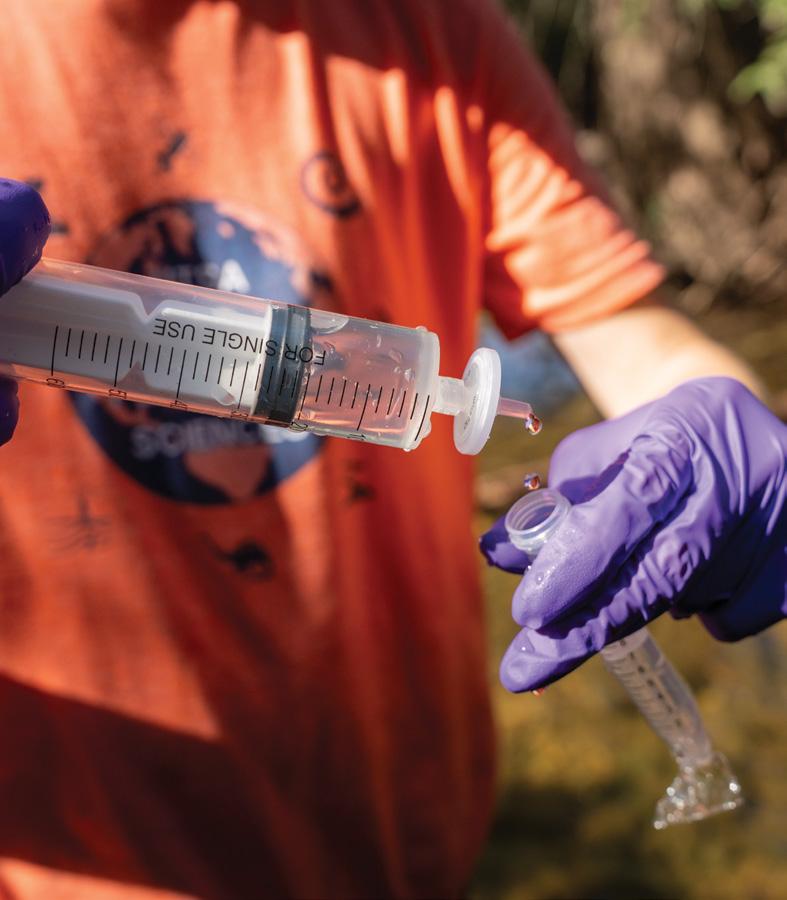
University


BEATING THE HEAT
Researchers are working with the community to mitigate the sweltering heat in San Antonio’s urban core.
18
TOGETHER ON THE FRONTIER OF BRAIN HEALTH RESEARCH
Explore the enormous potential for brain health research at the newly unified university, and read three stories about Roadrunners on the frontlines of brain science and behavioral health.
24
TAYLOR EIGHMY
PRESIDENT
JOE IZBRAND
ASSOCIATE VICE PRESIDENT FOR STRATEGIC COMMUNICATIONS AND EXTERNAL AFFAIRS
MARGARET LAMAR
MANAGING EDITOR
VALERIE BUSTAMANTE JOHNSON
SHEA CONNER
SENIOR EDITORS
CHRISTI FISH
SHARI BIEDIGER
ASSOCIATE EDITORS
ARI CASTAÑEDA
AMANDA CERRETO
JOHN ELIZONDO
MICHELLE GAITAN
KC GONZALEZ
KARLA HIGNITE
LETY LAUREL MATOS
JOANNA QUINTANILLA
CONTRIBUTING WRITERS
CORAL DIAZ GRAPHIC DESIGNER
TRACI DABERKO ILLUSTRATOR

'RUNNERS & SHAKERS
An ACL injury nearly derailed Jordyn Jenkins’ career. See how coaches and the sports medicine staff helped her bounce back for an unforgettable senior season.
CONTACT US
We want to hear from you. Do you want to share your thoughts on one of our stories? Or would you like to change your contact details?
EMAIL: SOMBRILLA@UTSA.EDU
SOMBRILLA MAGAZINE
OFFICE OF UNIVERSITY STRATEGIC COMMUNICATIONS
ONE UTSA CIRCLE SAN ANTONIO, TX 78249-1644
SUBSCRIBE TO SOMBRILLA MAGAZINE ONLINE: SOMBRILLA.UTSA.EDU
Sombrilla Magazine is the official publication of The University of Texas at San Antonio. It is distributed without charge to students, alumni, faculty, staff and the Roadrunner community. The magazine strives to capture the intellectual, cultural and social life of the university.
sombrilla /sohm–BREE–yah/ Spanish for Umbrella

UTSA and UT Health San Antonio have joined forces as UT San Antonio — one world-class university poised to transform the region’s economy, boost educational opportunities and make lives better.

BY SHEA CONNER

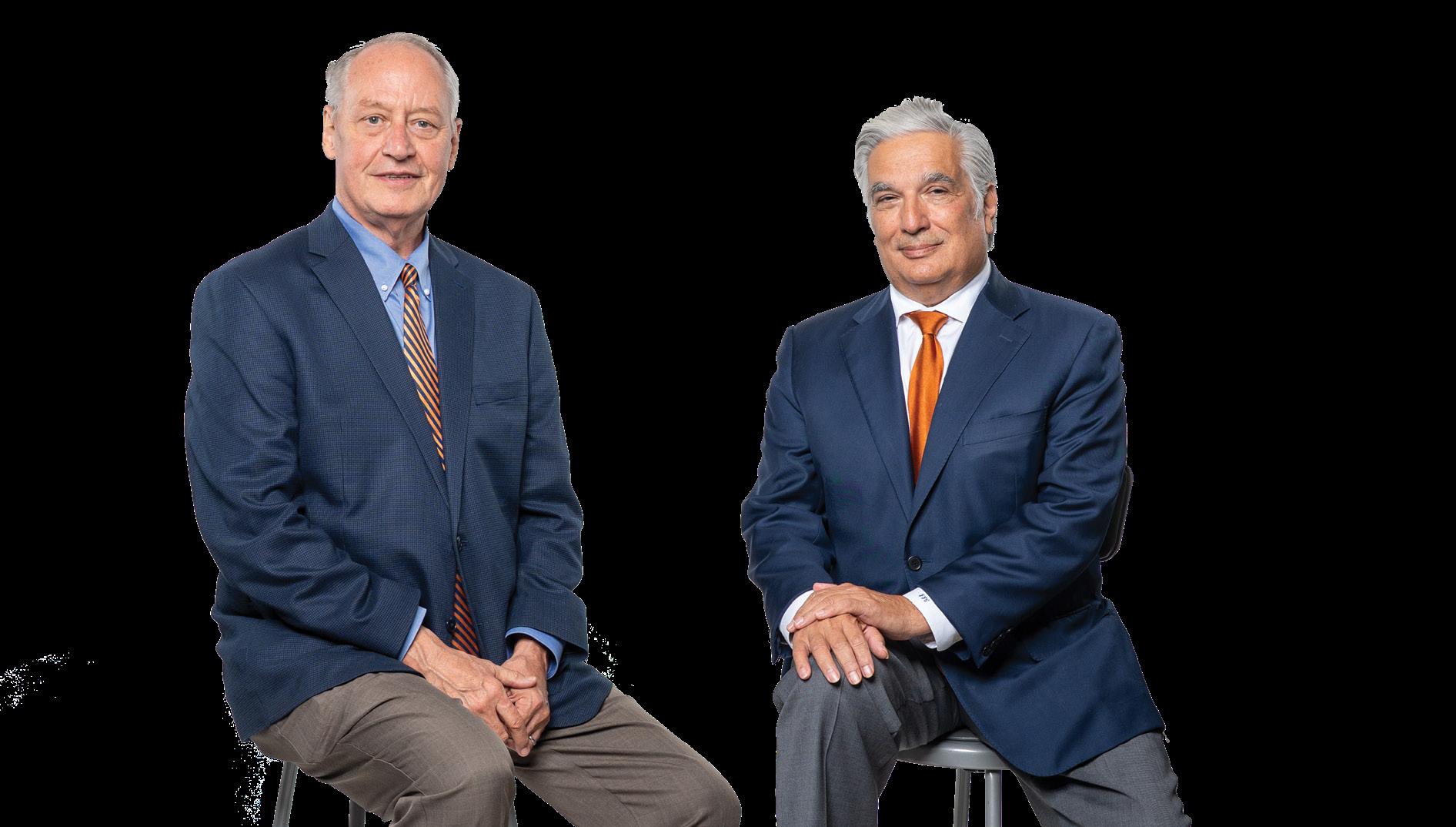
Discussion about UTSA and The University of Texas Health Science Center at San Antonio coming together under one metaphorical roof had persisted in some fashion for decades. But when the UT System Board of Regents and leaders at both institutions started deeply thinking about the synergies between the two universities, a captivating vision materialized — and those passing “what-ifs” suddenly gave way to exciting, engaging conversations.
“Whether you’re improving lives through medical intervention, healthcare and public health or you’re improving lives through educational attainment and upward social mobility, they both produce an outcome of making lives better,” President Taylor Eighmy explains. “We had this ‘a-ha’ moment when we realized the core missions of each of the institutions were actually identical in spirit: in terms of why we are here, why we serve and who we serve.”
That a-ha moment was the genesis for a monumental announcement. In August 2024, the Board of Regents unveiled an ambitious and visionary plan to merge UTSA and UT Health San Antonio to establish one premier public university known as UT San Antonio. On Sept. 1, 2025, the two institutions, after years of speculation, finally became one university fiercely dedicated to making lives better.
The teams of Sombrilla and Mission magazines sat down with Eighmy, president of UT San Antonio, and Francisco Cigarroa, the university’s senior executive vice president of health affairs and health system, to discuss the timing and importance of this historic integration in addition to the positive impacts it will have on San Antonio, the state of Texas and the national research landscape.

TAYLOR
Whether you’re improving lives through medical intervention, healthcare, and public health or you’re improving lives through educational attainment and upward social mobility, they both produce this outcome of making lives better.
Why Now is the Right Time
UNIFYING THE TWO INSTITUTIONS WILL ELEVATE BOTH TO NEW LEVELS
The UT System Board of Regents considered studies on merging UTSA and UT Health San Antonio twice before, in 2002 and 2010. Cigarroa remembers, in particular, that State Sen. Leticia Van de Putte was determined to make it happen in 2010 because she saw the potential impact of the two institutions unifying their resources. She felt that an integrated university in San Antonio would be well-positioned to eventually become a top-tier research university and be eligible for additional funds to enhance research from the Texas Legislature.
In the same context, Senator Kay Bailey Hutchison would often ask regents and chancellors how Texas could establish an additional university designated by the Association of American Univerisities (AAU), which is the highest designation of a university in the U.S. and Canada. These universities are the very best in education, research, innovation and discovery. “Senator Hutchison would often state that California has nine (AAU institutions), New York has seven, but our great state of Texas only has three,” recalls Cigarroa, who was serving as chancellor of the UT System at the time. “She actually challenged us to figure out a way of creating a fourth AAU university.”
The last study assessing the feasibility of a merger, led by former UT Austin and UTSA President Peter Flawn, concluded that the timing was not quite right for a merger in 2010 but that it ought to be strongly considered in the future. In 2024, the UT System Board of Regents felt the time was perfect to pursue an integration between the two San Antonio institutions. Such a merger would elevate the city to the nation’s forefront in education, discovery, biomedical science, healthcare and digital technology. It would also result in the creation of one of the nation’s top public universities with a focus on excellence and access with the biggest beneficiaries being the students and region we serve.
The UT System Board of Regents is well known to be visionary and bold, and the decision to move forward with the merger of UTSA and UT Health San Antonio is aligned with this spirit. “It took true leadership from our Board of Regents to go in on this because of the size and scale of it, but I think both institutions had to be ready for this,” Eighmy explains. “Both were on steeply positive trajectories. With all of the progress that’s happened at UT Health San Antonio over the last 15 years under Dr. William Henrich and the progress at UTSA over the last decade, the time was right.”
This integration not only establishes UT San Antonio as a premier institution but also puts the newly-integrated university on the path to joining The University of Texas at Austin, Texas A&M University and Rice University as the Lone Star State’s fourth AAU member.
“Taylor Eighmy and I understand that it’s a huge responsibility, but it’s also a once-in-a-lifetime opportunity to merge these two very outstanding universities into one,” Cigarroa says. “That’s a special calling.”
“And we’re going to go big on this,” Eighmy adds.
EIGHMY PRESIDENT OF UT SAN ANTONIO
‘Big Impact’: UT San Antonio’s Emerging Status
FROM THE ECONOMY TO RESEARCH, THE NEW UT SAN ANTONIO WILL BE A MAJOR PLAYER IN THE STATE
On Sept. 1, UT San Antonio became one prodigious university boasting more than 40,000 students and 17,000 employees. It became a consolidated institution with annual research expenditures of about $486 million and an endowment of approximately $1.3 billion that now generates $7 billion per year in economic impact. UT San Antonio also surpassed many great institutions to firmly establish itself as the third-largest research university in Texas, trailing only Texas A&M and UT Austin.
To say it’s one of the greatest mergers in the history of American higher education wouldn’t be overstating its significance, Eighmy explains.
“In my conversations with presidents around the country who are keenly
interested in what we’re creating here, they’re all in awe of our potential. They also realize that our shared impact will be so profound when we are formally brought together,” he says. “Now we have the gravitas of being an institution that can and will have a really big impact on solving society’s grandest challenges.”
Beyond the university’s soaring status, Eighmy says he’s especially excited for current and future UT San Antonio students. They can feel assured knowing that they’re getting a top-tier education, he says, with more handson learning experiences, collaborative capacity and professional opportunities in front of them than ever before.
Most importantly, the San Antonio region — one of the fastest-growing and
developing areas in the U.S. — now has the kind of premier public university that it has long deserved.
“I do believe that we are going to be one of the great universities of the 21st century,” Cigarroa says. The opportunity to create this university that’s going to significantly excel and catalyze education, research, healthcare and translational science is profoundly large.”
“We became a world-class university on day one of the merger,” Eighmy says. “In spite of the headwinds that higher education is presently facing, it is really important to emphasize that there is so much opportunity in the state of Texas. If you give us 10 years, we are going to go to the moon.”
Leveling Up in the Lone Star State
UT San Antonio is now the thirdlargest research university in Texas. The combined total research expenditures of UTSA and UT Health San Antonio in 2024 have established the university’s impressive new standing among the state’s comprehensive doctoral-granting public universities.
A New National Research Powerhouse
THE NEW UNIVERSITY PLANTS ITS FLAG AS A LEADING HUB FOR COLLABORATIVE RESEARCH AND TRANSDISCIPLINARY DISCOVERY
The merger of UT Health San Antonio and UTSA united two R1designated institutions, recognized for their “very high research activity” by the 2025 Carnegie Classifications. UT Health San Antonio was already a major contributor to the city’s $44.1 billion health care and biosciences industry, and translated medications, treatments and therapies that changed the lives of people in San Antonio and around the globe. Meanwhile, UTSA had announced a new plan to hire clusters of faculty scholars to expand its core capabilities and expertise in key areas such as brain health, microbiome, artificial intelligence and materials science. Now unified as one, UT San Antonio will be the home to six federally funded research and development centers. This university will provide the environment for Nobel Laureate levels of discovery and other remarkable successes by our faculty, staff and students.
By pooling these resources, the new university will not only reinforce
Imagine the Possibilities
The new UT San Antonio will bring colleges and schools from both institutions together — creating exciting new opportunities for collaboration and discovery in research, academics and community impact.
San Antonio’s position as a launchpad for innovation but will also elevate the region’s reputation of research excellence and scientific influence in national conversations.
“The very best institutions — the University of Washington, the University of Michigan, the University of California, Los Angeles, UC San Diego, UNC-Chapel Hill — all have incredibly large academic medical centers and very large academic institution components with research happening in both places,” Eighmy explains. “The model of bringing our two institutions together really matches that construct.”
From the impacts of artificial intelligence on medicine and cybersecurity on health services to collaborative advancements in biomedical engineering and biochemistry, the merger will lead to innovative breakthroughs in translational science and improved health outcomes.
“We are creating a new world-class university here that has even more
of the ingredients of collaborative research and transdisciplinary discovery between medicine and the basic sciences than any other public institution in Texas,” Eighmy says. “You couldn’t ask for any better ingredients.”
The newly unified UT San Antonio will also be much better positioned to yield more funding for vital research projects from major foundations, private sector state agencies and federal agencies like the National Institutes of Health and the National Science Foundation.
“Our research funding opportunities have been catalyzed. Having new synergies between different disciplines and bringing different faculty together is going to allow us to write the very best, most competitive grants and earn our fair share of funding,” Cigarroa says. “It’s a competitive world, but we’re all Roadrunners now and we’re going to win those races.”

Excellence Attracts Excellence
UT SAN ANTONIO WILL CREATE NEW CAREER PATHWAYS AND ATTRACT TALENTED FACULTY AND RESEARCHERS TO THE CITY
Bringing UTSA and UT Health San Antonio under one banner will not only lead to greater innovations in research and translational science. The resources available at UT San Antonio will also draw more of the world’s most talented educators and researchers across hundreds of disciplines to the city.
“UT San Antonio is going to enrich the culture that makes San Antonio — and the entire region that we live in — not only the best place to raise a family, but also the best place to study and the best place to work,” Cigarroa says.
At a highly touted academic research and academic health institution like UT San Antonio, faculty, doctoral and postdoctoral researchers will have expanded opportunities to see their scientific work translated into real-world applications. This could potentially lead to more prominent international research collaborations and other partnerships or local initiatives that could positively benefit the region, Eighmy explains.
“Excellence attracts excellence. Excellence attracts opportunity. Excellence attracts resources. Excellence creates impact. Excellence drives the world,” Eighmy says. “And what we’re intending to do is promote this evidence of excellence that we already have at each respective institution to build a strong foundation for this new world-class university we’re creating.”
The newly integrated UT San Antonio is now more appealing to promising undergraduate students as well. In addition to learning from accomplished faculty, they will have more pathways available in the future to unique master’s and doctoral degrees that will offer them advanced and specialized training not offered by many other universities in the United States.
One dual degree program at UT San Antonio that melds the expertise of the two previously separate universities is the MD/MSAI, the only program of its kind in the nation. Students in this program earn a Master of Science in Artificial Intelligence and Doctor of Medicine to enter the workforce as skilled physicians who can uniquely lead in the practical use of AI to improve diagnostic and treatment outcomes. Cigarroa envisions many more of these kinds of cutting-edge dual degrees springing up at UT San Antonio in the near future.
“We’re going to be able to foster new dual degree programs that we’ve never had before. When those synergies of expertise come together, that allows us to innovate. And that’s going to be available now to undergraduate students, to graduate students, to faculty and to scientists across the spectrum of this new university,” Cigarroa explains. “This really is one of the greatest decisions that the UT System Board of Regents has ever undertaken.”
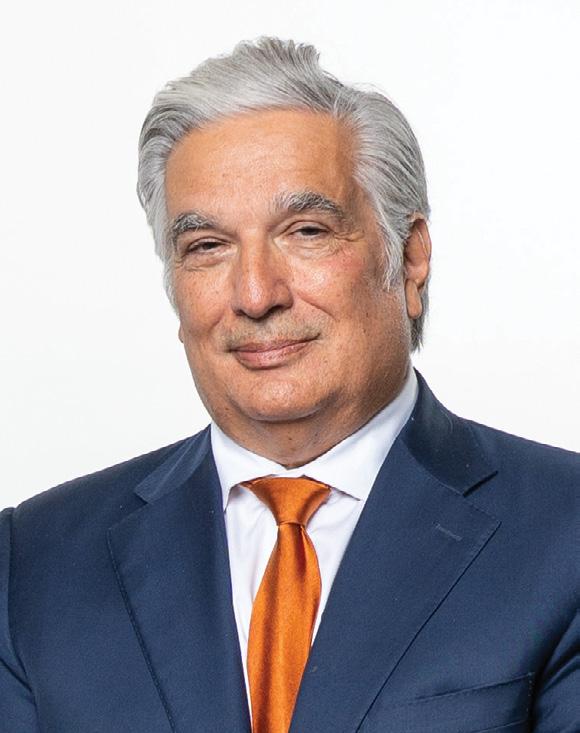
UT San Antonio is going to enrich that culture that makes San Antonio — the region that we live in — not only the best place to raise a family, but the best place to study and the best place to wor k .
FRANCISCO CIGARROA SENIOR EXECUTIVE VICE PRESIDENT OF HEALTH AFFAIRS AND HEALTH SYSTEM
A Beacon for Opportunity and Access
THE UNIVERSITY STRIVES — AT A PROLIFIC LEVEL — TO MAKE COLLEGE AFFORDABLE AND PUT ITS GRADUATES ON A PATH TO SUCCESS
Eighmy and Cigarroa share a fundamental belief that even though UT San Antonio’s profile is rising around the world, its collective mission to drive upward social mobility in South Texas will remain a top priority. In other words, “access” will be just as important as “excellence.”
“This university will give any individual the opportunity to fulfill their aspirations,” Cigarroa says.
Months before the two institutions merged, UTSA earned the brandnew designation as an Opportunity College and University by the Carnegie Classifications, which recognized approximately 16% of universities in the U.S. as models for fostering student success and promoting upward social mobility. The institutions that earned this designation were lauded in large part for “higher access” and “higher earnings.” Simply put, they are expanding paths
Where Excellence Meets Access
UT San Antonio is one of only 21 higher education institutions to earn both the R1 and Opportunity Colleges and Universities designations from Carnegie. These designations point to the nation’s greatest universities with a dual focus on research excellence and student success. In other words, these universities are creating successful paths to competitive earnings for students in their communities and giving them the opportunity to learn from respected faculty and innovative researchers.
to bachelor’s and graduate degrees for their communities, and their students earn higher average incomes than their peers after graduation.
Making college more affordable had been a consistent goal for several years for UTSA, where many initiatives were put in place to ensure that fewer financial hurdles stand in the way of talented students who want to pursue a high-quality college education. By the spring of 2025, UTSA graduates were leaving school with $5,000 less in student loan debt than the national average and $4,000 less than the state average. In fact, 39% of students graduate with no loan debt whatsoever.
Roadrunners have also been seeing profound returns on their investment. The average salary of UTSA students who graduated in the last three years is $65,000, well above the average salaries in the San Antonio metro area and Texas at large. U.S. News & World Report, Forbes
and The Wall Street Journal all recognized UTSA as a top performer in advancing social mobility before the institution merged with UT Health San Antonio. With expanded pathways to advanced medical, dental and other health professional degrees, UT San Antonio will now be among the nation’s most prolific providers of access to a lifetransforming education.
Eighmy is quick to point out that UT San Antonio is one of only 21 universities in the nation — and one of just four in Texas — to hold both the R1 research and Opportunity Colleges designations from Carnegie. This is an important development for San Antonio.
“We are going to keenly focus on expanded access and opportunities to elevate the educational attainment of our community here in San Antonio, across the region and all throughout Texas,” Eighmy says.

Shaping San Antonio’s Future
THROUGH EDUCATIONAL ATTAINMENT AND WORKFORCE DEVELOPMENT,
UT SAN ANTONIO AIMS TO LIFT THE ALAMO CITY
In 2024, the greater:SATX Regional Economic Partnership released a report exploring the workforce outlook for San Antonio. The report found that the region’s educational attainment rate — the percentage of individuals with a twoyear associate’s degree or higher — trailed every competitive metro area, from Seattle, Phoenix and Denver out west to Nashville, Charlotte and Washington D.C. out east.
This hasn’t just been a detriment to individuals and their families in San Antonio but has also stymied development in the region. Several notable employers have passed over San Antonio when seeking new locations for corporate headquarters or large office operations in the past because they felt the region didn’t have a college-educated workforce large enough to feasibly support such expansions.
“Fortune 500 companies and other large employers want to know: Do we have the university educational systems? Do we have the community college districts? Do we have advanced universities that are tier one in research to create the pipeline that’s required now for the future of work?” Cigarroa asks.
The collective efforts of institutions like UTSA and Alamo Colleges, which launched the Bold Promise and Alamo Promise tuition programs in 2019, have already helped turn the tide. San Antonio’s educational attainment rate shot from 35.6% in 2018 to 41.9% in 2022. Now, the new UT San Antonio is poised to provide a sea change for economic and workforce development in the San Antonio region.
As an example, Cigarroa explains that UTSA’s strengths in AI, computer science and engineering, and UT Health San Antonio’s strengths in biomedical education, research and clinical care are highly complementary. The newly consolidated university will produce more skilled graduates in those coveted fields and more collaborative research where
those fields overlap. As philosophy, art, politics, economics and scientific innovation increasingly intersect in society, UT San Antonio will also create more cross-disciplinary opportunities between the humanities and sciences. In turn, this will entice more partners and employers looking to stake their claims in the Alamo City.
“In every metric that I see, this integration is going to develop new innovations that are translated to market,” Cigarroa says. “It’s going to spin out new companies, as it already has in artificial intelligence. It’s going to lead to drug development, which will bring pharma into San Antonio. It will produce engineers that could help our city, our community and our state with transportation needs. It’s a very powerful investment in the pipeline of our future workforce.”
The merger also gives UT San Antonio the opportunity to cast a wider net in the region and to offer its united expertise and resources to any community partner who could benefit from them. Eighmy has often been quoted as saying that “great universities need great cities, and great cities need great universities.” Positioning a world-class university to grow alongside a booming region isn’t just something that’s necessary; it’s paramount.
“If we don’t lean in at the local level — if we aren’t working with our government, civic organizations, our business community or our fellow education and healthcare providers — we are losing the opportunity to maximize this impact,” Eighmy says. “If you think about the real significance of the merger’s impact, it has to go beyond the direct benefit to our institutional community members, as important as that is. We play an absolutely critical role in driving the development and growth of our city and our region. We have a moral responsibility to lead that effort.” S


Healthy Water, Healthy People
Graduate students Cassidy Lane (left) and Ronny Saunders (right) conduct water quality research at Cibolo Creek in Boerne as part of the Chemical Hydrology and Mass Spectrometry Lab in the College of Sciences. The lab focuses on issues of water resources and water availability in addition to better understanding the different metals and organic compounds found in the water. Research projects like this are often linked to key health impact assessments. Lane and Saunders hope that their efforts contribute to improved water quality that can bolster public health.
“I chose hydrology because it’s something that’s always going to be needed,” Lane says. “We’re always going to be drinking water.”
VISIT SOMBRILLA MAGAZINE ONLINE TO HEAR MORE ABOUT THE RESEARCH OF RONNY AND CASSIDY.
Living Well in a Growing City
University experts discuss the pressing health issues facing San Antonio

The most recent U.S. Census Bureau data showed that San Antonio was leading all U.S. cities in population growth. We had 22,000 new residents in 2023. Why are we growing?
POTTER: There are a number of things that have led to the increase in the pace of growth that we’ve been experiencing. We have growth industries here. Healthcare is certainly a big component of our economy in San Antonio. In addition to civilian healthcare, we have Brooke Army Medical Center and research and treatments that are cutting-edge compared to what’s available nationally or internationally. Of course, UTSA has really accelerated economic development within greater San Antonio — especially in regard to cybersecurity. The university brought CyManII to the city and the NSA now has a major complex at the National Security Collaboration Center. All of those things are attracting a skilled labor force to the city.
But then there’s what we refer to as the multiplier effect. So, you kind of have these core jobs, and then those people that are moving here need a house. That’s going to facilitate the
BY SHEA CONNER
construction industry. They’re going to be buying stuff, whether it’s cars or groceries. That will create other jobs that may be lower-skilled or lower-paid, but still attract individuals to come to San Antonio to find employment.
A lot of the biggest public health challenges in San Antonio are the same as they were a decade ago. Obesity is pervasive. Diabetes and heart disease are affecting some communities much more drastically than others. And San Antonio has historically had low educational attainment and income levels compared to other cities, which have driven down our health outcomes. In recent years, we’ve also seen more focus directed toward domestic violence and mental health. When you talk with your peers in the Department of Public Health, what are they concerned about?
CHEAK-ZAMORA: We concentrate a lot on the social determinants of health in our department, so we’re thinking about all of the things at the same time. Are people able to feel safe in their
homes and in their neighborhoods? Are they able to play or exercise around their homes? We think about education, jobs, incomes and how that provides them with the time as well as the resources to make good decisions about their health. We think about food availability. We think about the environment. How’s air quality? How’s pollution? How’s water safety? As you said, we’re trying to manage all of this at once.
We’re doing really well in some areas in San Antonio. Certainly, you know, on the North Side, there are a lot more parks and spaces for the community to do things. The schools are generally better there, so our educational attainment in those areas of San Antonio is fantastic, right? But certainly, on the South Side, we need to invest more there. We need to think more about how we’re providing the basic needs for all San Antonians. We really think about those disparities quite a bit and how — as a university and as a city — we can address the needs of everybody and not just people in certain pockets of the city.
San Antonio has emerged as one of the fastest-growing cities in America, but how is that explosion in population growth having an impact on our most pressing public health challenges? Sombrilla Magazine sat down with Lloyd Potter, Texas State Demographer and professor of demography, and Nancy Cheak-Zamora, chair of the Department of Public Health and professor of public health, for a conversation about the intersection of public health and demography as well as how it’s all playing out in the Alamo City.



One of the most common public health issues that arises from population growth is water scarcity, and Texas is already staring down a looming water crisis in the 2030s and beyond. How is our community being thoughtful and proactive in addressing that?
POTTER: The San Antonio Water System has been ahead of the game in terms of ensuring that we have a diversified water supply. If you look at a lot of the other cities on the I-35 corridor, which is kind of the line between surface water areas and ground water areas, most of the other cities along that line don’t have a huge pipeline bringing water from the northeastern part of the state to supplement the sources of water that we’ve already had. I think San Antonio is pretty well-positioned in terms of having a long-term focus on water availability, and again, that’s not true for a lot of other cities in Texas.
CHEAK-ZAMORA: In the ’80s and ’90s, we were getting 100% of our water from the Edwards Aquifer and now it’s only half. San Antonio has had plans to diversify even further for many years. That’s important. As a city, I think we do need to be thoughtful about how we’re utilizing water.
Can we change the norms about how we use water outside of our homes — in our gardens, for our grass and for our cars? Across the United States, we may need to rethink how we’re prioritizing water use and make some choices that might feel uncomfortable right now.
One thing you often see in growing cities are green spaces giving way to new housing developments. But access to green spaces — whether it’s parks, trails or community gardens — is often a top priority for families when choosing where to live and is directly correlated to improved health outcomes. Why are parks and green spaces beneficial for public health? And from a development standpoint, would you say the San Antonio region is adequately prepared for its projected growth?
CHEAK-ZAMORA: Regarding the benefits of green spaces — or even just walking, being out and getting fresh air — we’ve seen medically that it increases serotonin, a chemical that effects our mood and ability to learn. It also decreases

things that are associated with heart disease and depression. So there are physiological benefits to getting outside and being in areas with more trees. It also reduces stress. Social cohesion is important, too. Seeing more people out makes you feel less isolated. These are all benefits of being out in parks or nature in addition to physical exercise.
POTTER: I think anything that was designated as a recreational space in San Antonio is probably not getting developed, and the places that are being developed are largely former cow fields or areas that were agricultural. But that said, some of the challenges that are created by developing in those areas is that the infrastructure isn’t always there. We have to make sure we have the capacity for managing sewage, garbage, police, fire and all of those things that go with it.
In addition to the general population in San Antonio, the number of children and the elderly who need extra care is also going up significantly. How does that affect day cares, assisted living facilities and nursing homes?
And what impact is that having on families who need to find a way to afford that care?
POTTER: Child care is a challenge given that we have a high rate of poverty in our population. That often means that both parents are working — and working long hours at relatively low-income jobs — which creates a greater need for child care. San Antonio has Head Start programs dispersed pretty well across the city. We also have Pre-K 4 SA, which is not child care per se, but it essentially provides a place where people can send their young children during a big part of the day and they usually provide afterschool care as well.
CHEAK-ZAMORA: And when it comes to elderly care, one thing that’s interesting about San Antonio is that we have a lot of multigenerational households compared to other cities. That’s fantastic. We actually know that multi-generational households are better for everybody. It’s often better for kids because they’re experiencing mentorship and seeing firsthand how people live at an older age. It’s much better for seniors because they’re still getting a lot of interaction with their families. That’s good for San Antonio because we’re not overly stressing those facilities. But those families are still under a lot of pressure, so we need to find ways to make sure that the middle generation — the one raising the kids and also helping take care of their parents — also is getting support.
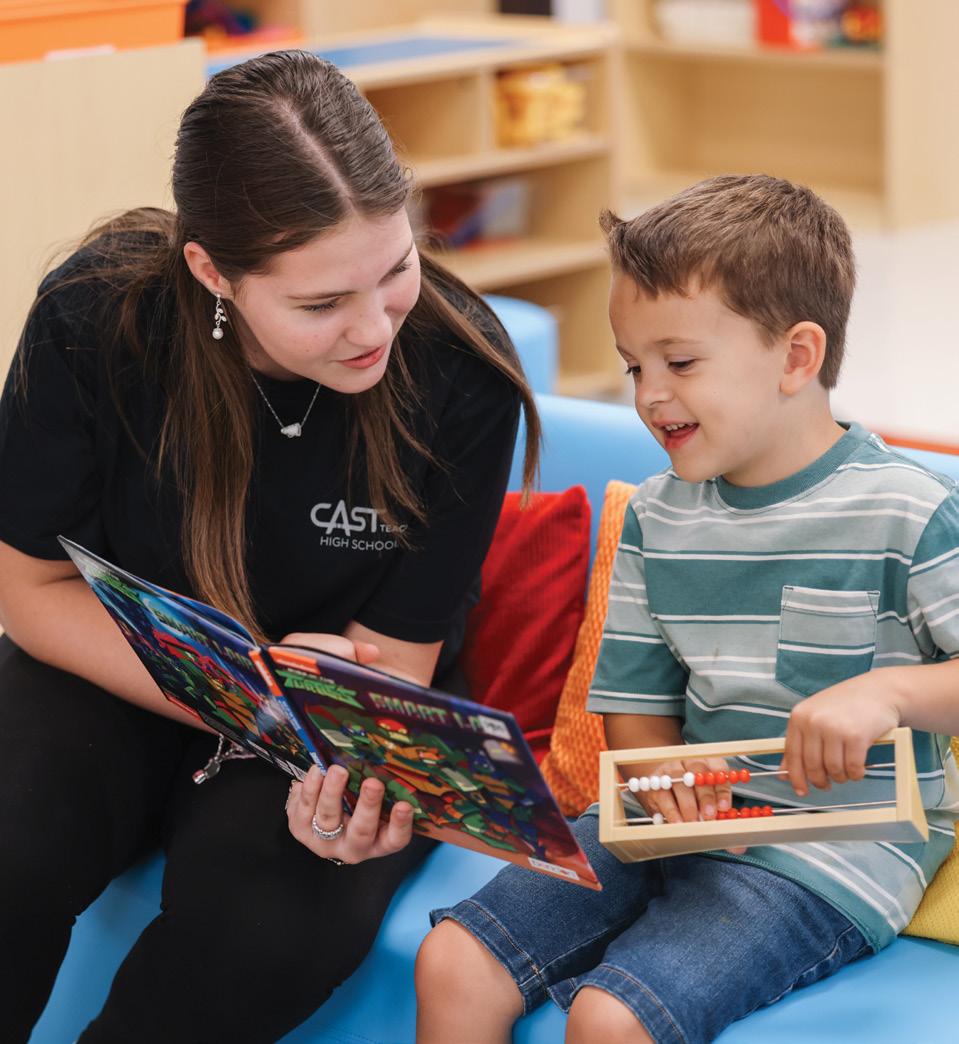
Educational attainment and economic stability are social determinants of health in which San Antonio has lagged behind other major cities in the U.S. UTSA has been working hard in recent years to help close that gap — not only to improve social mobility for its graduates, but also to foster workforce and economic development in the region. Are we seeing a significant uptick in education and income in our region?
POTTER: Yes, educational attainment has been going up pretty much for all groups in Texas. I think we can attribute that to our higher ed institutions. Alamo Colleges has done a tremendous job in terms of working with high schools, offering dual credit and trying to facilitate a smoother move from high school into some kind of postsecondary education.
UTSA and Texas A&M University-San Antonio have great outreach efforts in our local high schools. And both are collaborating with Alamo Colleges on the Alamo Promise program. Now, people who might have stopped after getting a two-year associate’s degree are more frequently coming to UTSA to earn a bachelor’s degree. So I think those efforts are paying off.
CHEAK-ZAMORA: I would imagine that what UT System is doing to reduce tuition is going to have some great benefits as well. The new effort to expand Bold Promise for Texas families making $100,000 or less will open up new possibilities to those who never would have thought of going to college because of the
potential for incurring debt. That is a win-win for San Antonio and Texas.
One of the things the Department of Public Health is doing, and we’ll need to continue doing, is connecting our students to the workforce. As the chair of a department, I want all of my students to be able to get a job right after they graduate. And we see this time and time again with our students — when they get a job, they’re helping their families and raising them back up. There’s a multigeneration effect. We need to continue to support our students and provide them with workforce resources, so they can continue to have that impact for themselves and their loved ones. Ultimately, good jobs and good incomes are huge drivers of all of the other social determinants of health. S
VISIT SOMBRILLA MAGAZINE ONLINE TO READ THE EXTENDED CONVERSATION
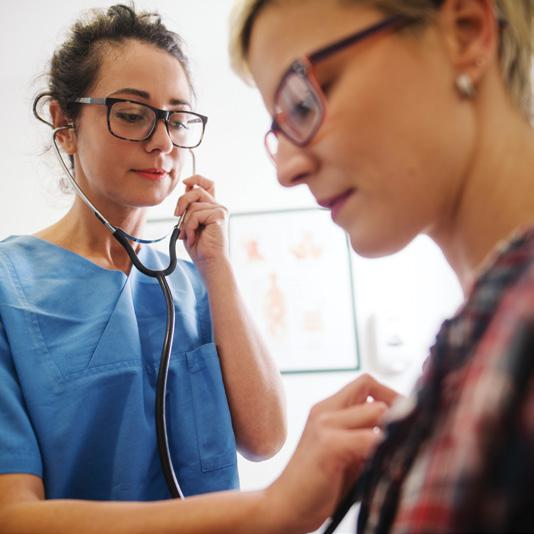

The People’s School
BY VALERIE BUSTAMANTE JOHNSON AND MICHELLE GAITAN
How the School of Public Health is addressing the needs of the community
Most of us are used to seeking out healthcare professionals when we are sick, injured or just need routine care. And yet, what many don’t realize is that working parallel to the medical field, public health professionals are working at the population level to improve the quality of lives through health and wellness promotion and illness prevention.
Whether it’s providing access to summer food programs to address children’s food security or creating policy for safe water, public health researchers and practitioners are working with the community to make lives better.
In 2024, UTSA and UT Health San Antonio — now integrated as UT San Antonio — joined forces to help accelerate those efforts with the launch of the University of Texas School of Public Health San Antonio (School of Public Health).
“We call our school the ‘people's school’ because we want to be people-centered,” says Vasan Ramachandran, founding dean of the School of Public Health. “We are very much grounded in the community. That’s where we want our research experience, our teaching and our service to be.”
Ramachandran adds that the school works with a number of iconic community-based organizations that are grounded in public health. “Each student in the graduate program is committed to 180 hours of applied practical experience. This experiential learning is community-situated. It’s a form of community service learning,” he says.
The U.S. Bureau of Labor Statistics reports that the field of public health is expected to grow approximately 17% by 2030. Based on data from the Texas Workforce Commission, community and social service occupations are expected to grow by more than 43,000 in Texas in the next six years.
While the new school is ready to contribute to the growing public health workforce, it’s also ready to mold its programs and students to fit the field’s continuous evolution.
“The number of public health jobs is increasing, but the content of the public health workforce and the job is also diversifying,” Ramachandran says. “When we face a situation where we need to expand the public health workforce, I think we try to be as flexible as possible. Some part of it is through educational programming at the graduate and doctoral levels, in addition to creating a portfolio of skill sets that allows the existing public health workforce to upskill.”
He added, “We need health professionals who aren’t just in public health. We need dental and nursing professionals who are interested in public health and, of course, physicians who are interested in public health.”
Regarding UT San Antonio, Ramachandran states, “I think the possibilities are endless and I am incredibly excited about this merger and how we can work together. We have already been working together before the merger, so I hope we can continue to work together to exponentially increase the range of educational programming, the range of research and diversify our portfolio.” S
We are very much grounded in the community. That’s where we want our research experience, our teaching and our service to be.

WATCH A FULL VIDEO INTERVIEW WITH VASAN RAMACHANDRAN AT SOMBRILLA MAGAZINE ONLINE.
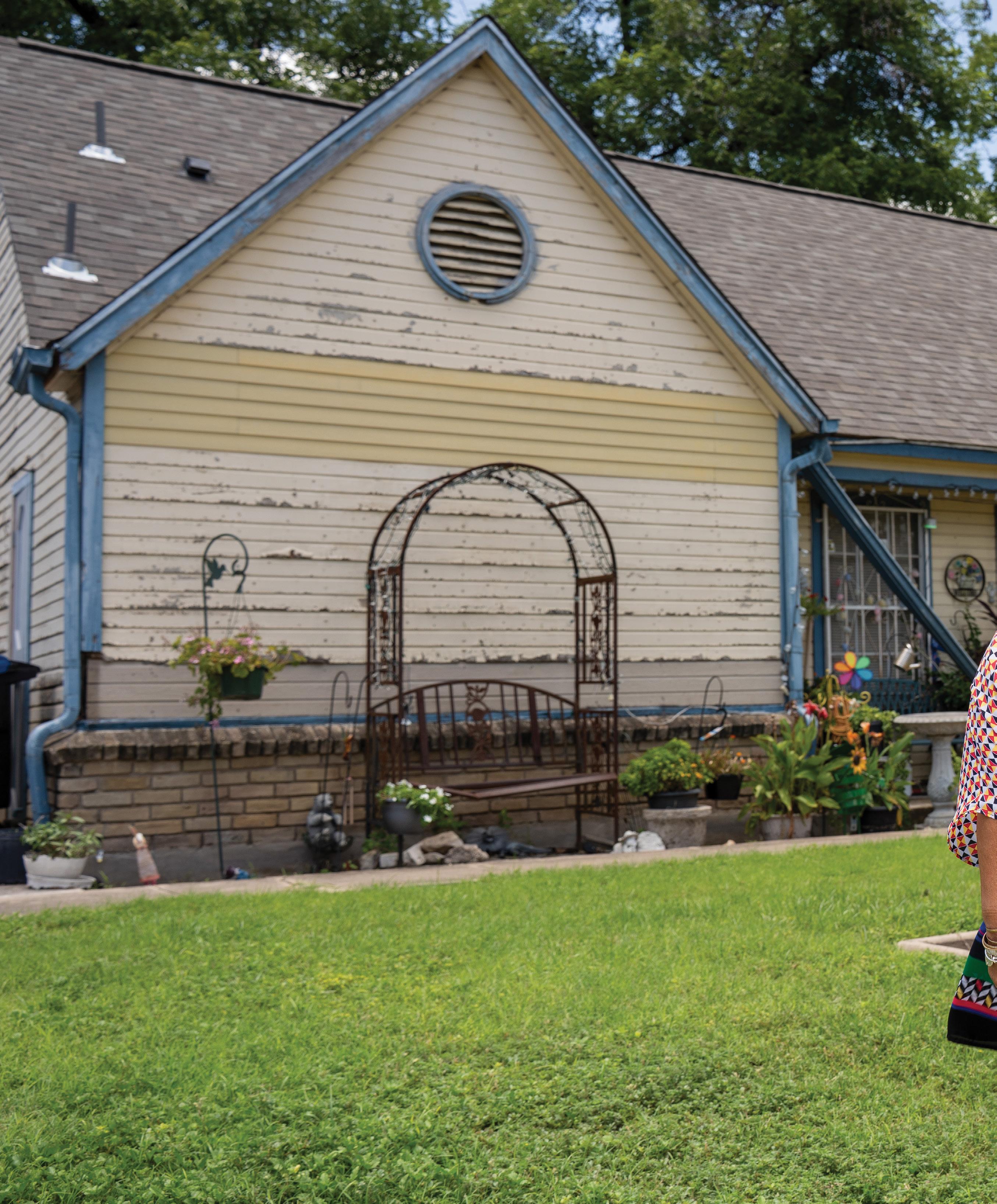
Beating the Heat
Beating the Heat
BY VALERIE BUSTAMANTE JOHNSON
Community-based solutions to the public health challenge of urban heat in San Antonio

when some residents of San Antonio’s Historic Westside neighborhood come home after a long workday, it’s not unusual for them to walk into a sweltering home that has been sitting all day unventilated and without airconditioning. As a result, they endure dehydration, cramps, heat exhaustion and heatstrokes.
“Several of them say they have a heatstroke once or twice during the summer,” says Esteban López Ochoa, associate professor in urban and regional planning in the Klesse College of Engineering and Integrated Design. “It is not fair nor efficient to have a large section of the population normalizing having heatstrokes in the summer due to extreme heat conditions in their own homes. And housing conditions is a greatly overlooked issue that needs to be prioritized.”
Perla Lara is a Westside resident who is working with researchers on ways that various conditions can lead to extreme heat in homes.
BRANDON FLETCHER/MARKETING
The Hottest Neighborhoods
While everyone is trying to beat the heat, not everyone is experiencing heat the same way.
Those who reside outside Loop 1604 have a different experience with heat compared to those who live closer to the city core, many of whom are living in “urban heat islands.”
According to the U.S. Environmental Protection Agency, heat islands are urbanized areas that experience higher temperatures than rural areas due to the lack of green space and the high concentration of buildings and other infrastructure that absorbs and re-emits the sun’s heat.
“When we design cities, we are changing the structure of the environment,” says Kristen Brown, assistant professor in civil and environmental engineering, and construction management. “In order to make things accessible, we have roadways, but those roadways are covering up what could be a field. When you add extra pavement for those mobility purposes, you add various things that are producing waste heat and removing ways for heat to leave the system.”
Brown and her team of researchers from the Sustainable, Pervasive Urban Resilience (SPUR) Center were tasked by the City of
The map shows the areas of Bexar County that are more vulnerable to heat.


San Antonio to determine what areas are most affected by extreme heat with the goal of directing resources to those most impacted.
To determine the hottest areas, the researchers analyzed satellite data from the Landsat program by NASA and the United States Geographical Survey over a course of four days and compared it with ground measurements from around the city.
Based on collected and calculated data, block groups of the city were assigned heat rankings between 1 and 10, a ranking of 10 being the hottest.
The researchers found that the hottest areas in San Antonio were inside Loop 410 and areas within U.S. 90, Interstate 35, Interstate 37 and Interstate 10, just outside the heart of downtown San Antonio.
The study also looked at different variables such as income, access
to healthcare, and access to transportation. Like the heat rankings, block groups were given scores from 2 to 10 with higher scores representing higher population of color and lower median income.
Using this data, the researchers created a Heat Vulnerability Index and map to show which areas are more susceptible to extreme heat.
“The Heat Vulnerability Index gave us a roadmap of where we should be paying most attention. Heat does not respect boundaries. It’s affecting all of us, but we know there are certain environmental issues that make heat more impactful to certain residents,” says Leslie Antunez, the City of San Antonio sustainability administrator. “This index has been our starting point to see what relief we can provide for our residents.”
Creating Healthier Homes
Researchers are turning to AI models and digital twin technology to strengthen resiliency in San Antonio’s Historic Westside community.
The team, led by Wei Zhai, an assistant professor of urban and regional planning, and Esteban López Ochoa, is creating digital twins of the Westside homes and the neighborhood to address some of the extreme heat conditions residents face in their living spaces.
partners launched a pilot project last year. In the neighborhood bordered by West Commerce, South Zarzamora, and South Laredo streets and I-10, they planned to conduct home condition assessments and learn how the urban built environment is affecting the residents.
Sometimes the most visible problem is not the most impactful problem in terms of health.
Digital twin technology, which is said to have been pioneered by NASA in the 1960s for space exploration, is a virtual representation or digital copy of a physical object. The digital twin, which is updated using real-time data, will allow the researchers to create a digital copy of the physical homes so that they can explore possible home rehabilitation solutions. Data from the digital version of the home which accurately reflects the real-life homes is then analyzed by AI.
A collaborative group of researchers from UTSA and the Southwest Research Institute, members of the the Historic Westside Neighborhood Association and other community
During this project, the researchers installed sensors at locations around the neighborhood to measure the “felt heat,” and they placed 20 sensors inside and outside residents’ homes to track how the homeowners experienced heat through humidity, temperatures, dew points, airflow and wind speeds.
“We joined forces with the community. We trained them. We took students to help out,” López Ochoa says. “We have been collecting data on all the exposures during the last year, but now we want to move
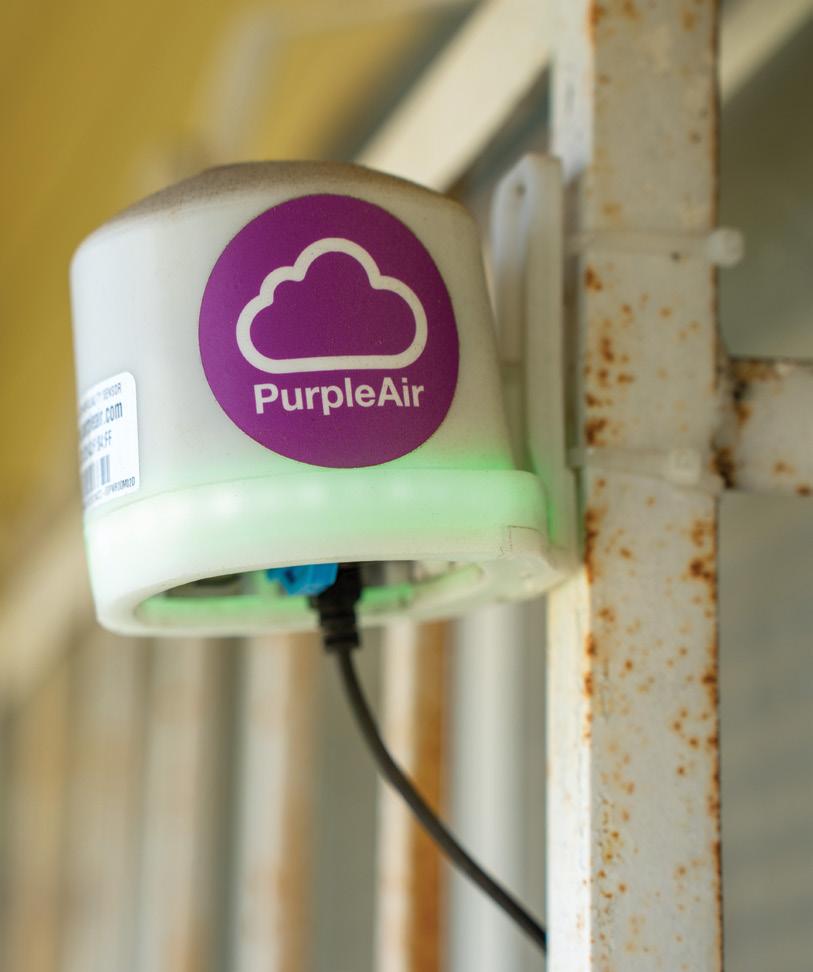
forward in terms of How can we fix these people’s homes? How can we give them information so they can understand, given the limited resources? Where should we put those resources first? Because sometimes the most visible problem is not the most impactful problem in terms of health. You may want to change the windows, but what would make a huge difference, maybe, is adding insulation.”
By using the digital twins, the researchers can go into the digital model to test a range of potential scenarios.
López Ochoa added that it’s like you’re in a game where you can walk through and see all the different parts of the home. This process will allow for predictive decision-making.
“With the digital twins, you can understand the parts of the home that are facing certain issues,” he says. “It’s like a sandbox for people to perform simulations. Through these simulations we can figure out if certain changes in the home could improve the issues. If we put a tree or put a shading infrastructure outside, would it be better or would it be worse?”
Perla Lara, who has the sensors in her Westside home, says that being part of the project has allowed her to learn more about her home’s environment and how hot her home actually gets.
“I’ve learned so much and am appreciative of these sensors. I love the sensor we have inside because it tells me how hot it is, especially when I have the dryer running and the stove on,” she says. “The sensor changes colors depending on the temperature. If it turns purple, it means it is way too hot and it alerts me. I didn’t know how hot it got in my house, so this is very impactful.” S

Staying Cool in the City
Researchers are partnering with the City of San Antonio to create innovative solutions to mitigate urban heat.

Building a Tree Canopy
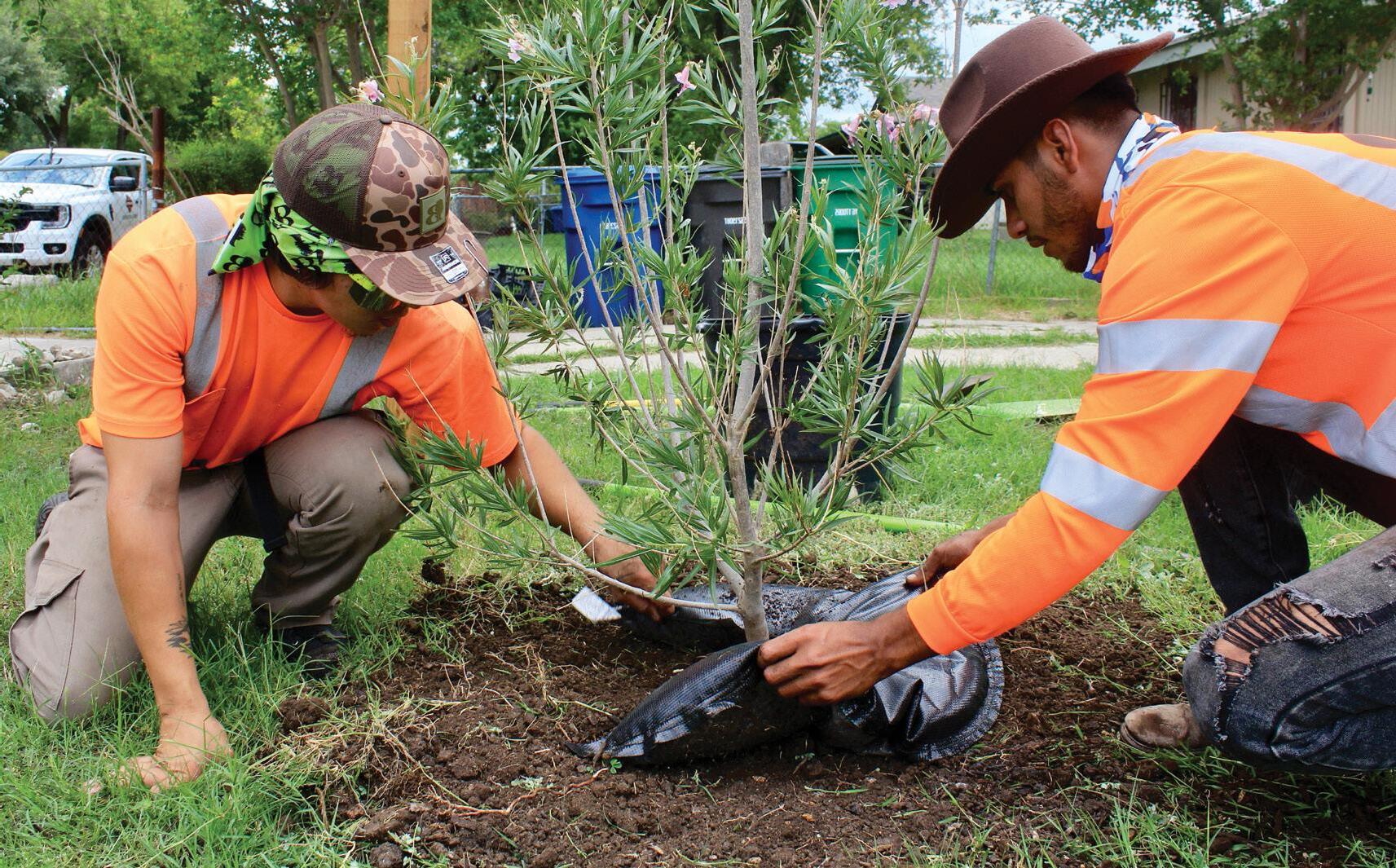

Urban tree canopies offer several benefits, including improved air quality, reducing urban heat and enhancing mental health. So the City of San Antonio has established an Urban Forestry division of the Parks and Recreation Department to help make the city greener.
The division spearheads the Tree Adoption Program, which distributes thousands of trees every year at city events, and the CommuniTree Program, where they are strategically planting trees in neighborhoods more susceptible to urban heat. The CommuniTree program gives residents in the hottest neighborhoods the option to have the City plant a tree on their property free-of-charge.
Ryun Jung Lee, assistant professor in urban and regional planning, has partnered with the city to evaluate participation in the program and create recommended strategies to increase future resident participation.


In 2023, the city added a water-based asphalt treatment called “cool pavement” to 10 small stretches of roadways across the city. Partnering with researchers at UTSA, this Cool Pavement Pilot Program study evaluated whether the effort would be effective for a citywide application. With two years of data and positive results, the city allocated $5.8 million for additional investments in cool pavement.

Cooling Roadways

Shade is Art, Art is Shade
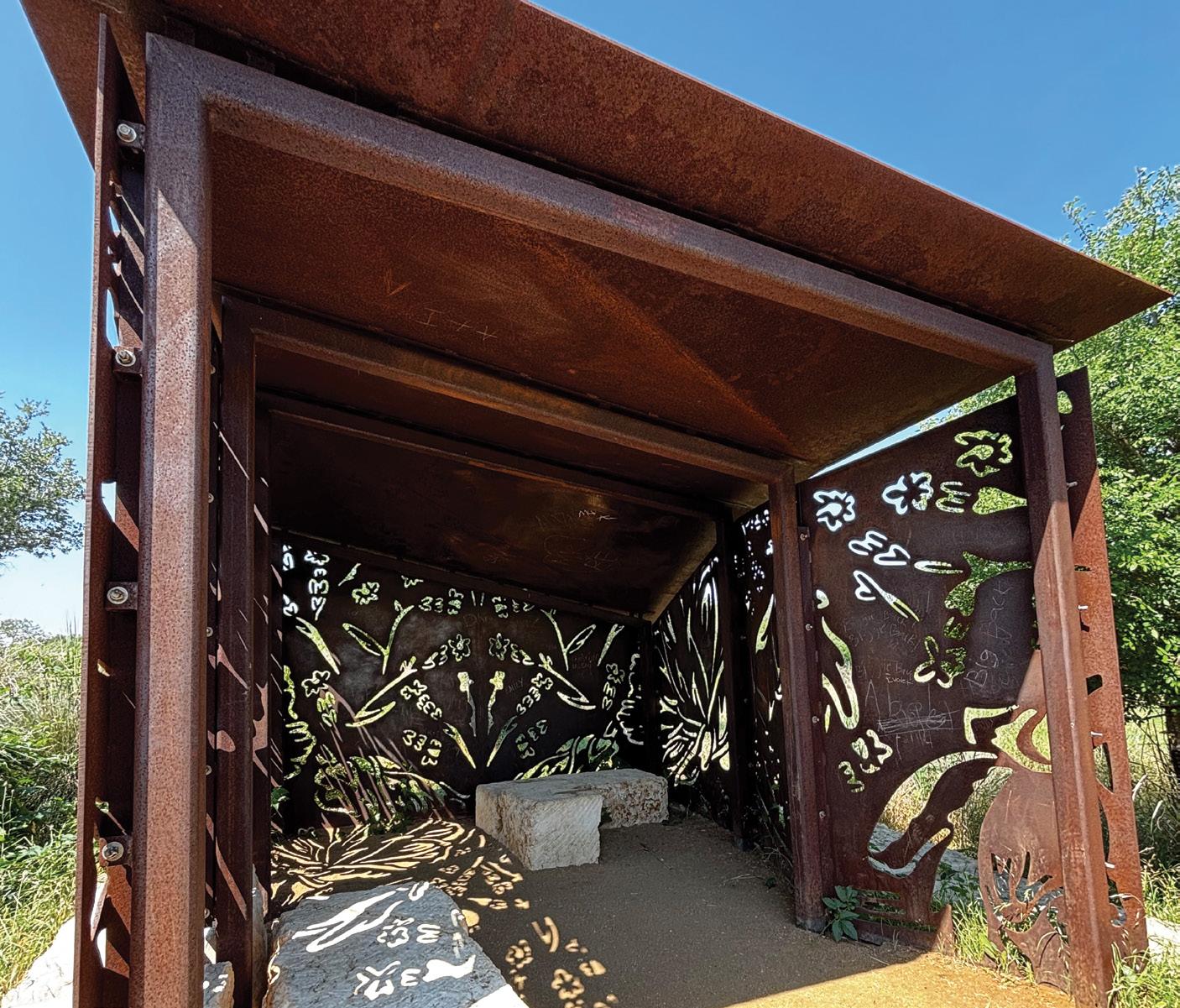

The city’s Department of Arts & Culture is spearheading the “Shade is Art, Art is Shade” initiative, where it is using the data from the heat index map to add public shade structures that double as community art installations. In 2024, VIA Metropolotan Transport was awarded $1 million from the city’s Resiliency, Energy Efficiency and Sustainability Program to add more shaded bus stops.

RESEARCH
Together on the Frontier of T
he merger between UT Health San Antonio and UTSA brings together two of the state’s most prolific research hubs with a shared mission of making lives better through innovation. While UT San Antonio’s research collaborations will have ripple effects across the medical and health professions, some of the university’s earliest and biggest breakthroughs are expected to come in the field of brain health.


The UT San Antonio Health Science Center houses more than 50 programs, departments and centers dedicated to improving brain health and serving the comprehensive brain health needs of patients. The Glenn Biggs Institute for Alzheimer’s and Neurodegenerative Diseases has earned nationwide acclaim. It’s the state’s only National Institute on Aging (NIA) designated center of excellence for dementia care and research, providing a comprehensive network of clinical care for patients and their families as well as access to the most advanced treatment.
The university has also invested $100 million in the new Center for Brain Health, a firstof-its-kind facility providing innovative care for patients with Alzheimer’s disease, ALS, dementia, movement disorders and other neurodegenerative diseases.
More frequent and extensive collaborations with the Brain Health Consortium, a large multidisciplinary research group at the university, could prove to be transformative. The consortium is identifying novel strategies to prevent disorders, promote development and restore brain function.
The Brain Health Consortium spans several areas of study, from stem cell and precision medicine to neuroscience and neuroengineering to psychology and learning. Using cutting-edge technology, the consortium explores brain mechanisms and also trains the next generation of brain health researchers and innovators.
At the new UT San Antonio, these skilled scientists, researchers and clinicians from various disciplines will come together for broader and more comprehensive brain study, which will lead to the development of new clinical treatments and therapies that could make all the difference.
Mitigating Impact
Researchers are developing helmet pads to reduce traumatic brain injury in military service members.
By Joanna Quintanilla

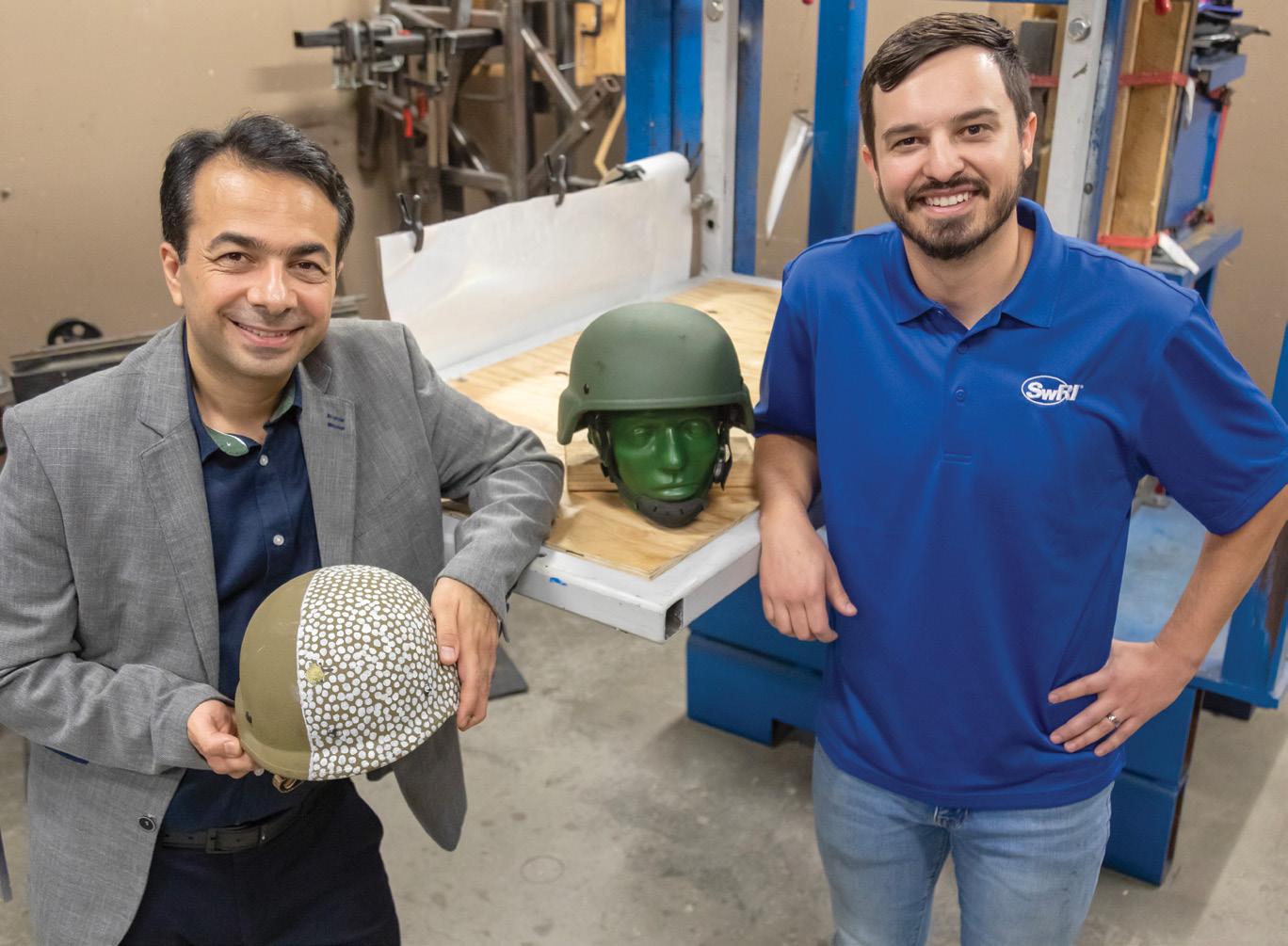
he public’s awareness of traumatic brain injury in football has soared over the last decade, but there’s another helmet-wearing, impactbearing population that often goes overlooked.
Partnering with Southwest Research Institute (SwRI), university researchers are creating innovative military helmet pads designed to prevent traumatic brain injury (TBI) for service members. The project, led by Daniel Portillo at SwRI and Morteza Seidi from the Department of Mechanical Engineering, is supported by a $125,000 grant from the Connecting through Research Partnerships (Connect) program.
TBI can affect human performance and quality of life for anyone, but it’s a critical concern in military settings, where service members are regularly exposed to environments that pose significant risks for blast exposures, blunt trauma and ballistic impact.
“The increasing incidence of TBI among military service members shows a pressing need for enhanced protective equipment in combat and training environments,” Portillo says. “The widespread use of improvised explosive devices and firearms has made TBIs particularly prevalent, and helmets are the primary form of protection against skull and brain injuries.”

The increasing incidence of TBI among military service members shows a pressing need for enhanced protective equipment in combat and training environments
The researchers will collaborate on a helmet that includes multi-behavior padding that becomes soft or stiff depending on the type of impact the wearer experiences. During a blunt impact, such as a fall, the padding will soften to cushion against the blow. A ballistic impact from shrapnel or a bullet will make the padding stiffen to absorb the object’s kinetic energy and prevent injury to the skull and brain.
“Ballistic impacts occur at extremely high speeds,” Seidi says. “They are very different from blunt impacts at relatively lower speeds, which is why it’s challenging to create a helmet that can protect against both.”
Dan Nicolella from SwRI and Marzieh Memar from the Department of Biomedical Engineering will lead the computer analysis of human brain response to evaluate the overall performance of padding in reducing the likelihood of brain injury.
The researchers will use 3D printing technology to build the helmet pads, and then test their ability to mitigate injury under various levels of both types of impacts, simulating real-world conditions.
“By leveraging the unique expertise at both institutions, we can improve the safety and wellbeing of military service members,” Portillo says. S


Miranda Boggan ’23 changes the lives of children with autism Beyond Behavior
by Valerie Bustamante Johnson
WWhen Miranda Boggan ’23 first started at UTSA in 2021, she wasn’t sure what field she wanted to pursue, let alone what sort of career she would end up pursuing after graduation.
Today, you can find Boggan making a difference in the lives of children and families that go through the Little Spurs Autism Center.
Boggan, a lead registered behavior technician (RBT), is helping children and teenagers with autism gain and build upon a variety of important skills, such as communication and socialization, allowing them to be successful in school and life.
“In the short time I have been an RBT, I have had several kids graduate ABA (applied behavior analysis) therapy to go to school full-time,” Boggan says. “I have gotten to hear so many inspirational stories from parents of different ‘firsts’ they have had with their kids, such as being able to go sit and eat at a restaurant. My favorite impact is seeing kids who are now utilizing coping strategies and communication instead of attempting selfinjurious behaviors. It makes every day so worth it, as I know it is truly making a difference.”
ABA is research-based behavior therapy for people with autism or other developmental disorders. The main goal of ABA is to increase positive behaviors and decrease harmful behaviors through positive reinforcement. It’s believed ABA
can improve socialization, communication and expressive language.
Boggan was first introduced to the behavior analysis field by accident.
“I found out about it from taking a class called Intro to Behavior Analysis, which I thought was going to be about behavioral profiling like they do in the FBI,” she says. “I started the class and realized it was a different type of behavior analysis that is used for people with special needs, especially autism.”
Intrigued by the work and ready to play a role in it, Boggan connected with Hannah MacNaul, assistant professor in the Department of Psychology, about gaining real-world experience in the field. Boggan thus began an internship at the Autism Treatment Center in San Antonio.
“I did the internship for a few months, working one-on-one with a client and had already seen such a difference in their behaviors,” Boggan says. “It made me want to look more into becoming a Board-Certified Behavior Analyst (BCBA) since they are the ones that create the interventions that the therapists implement. It was the first time I was able to visibly see the difference I was making.”
Since 2010, there has been an increased demand each year for BCBAs. Between 2022 and 2023, there was a 14% increase in the U.S., according to the Behavior Analyst Certification Board.
During her time at the university, Boggan showcased the work she was doing at the Autism Treatment Center during the Fall 2022
Roadrunner Experience Showcase, hosted by The Najim Center for Innovation and Career Advancement. The annual event allows students to present the work and lessons they’ve gained through internships, research projects and other leadership projects.
“After the event, I had a mom come up to me and thank me for the work that I was doing,” Boggan says. “She said she had a two-year-old who was recently diagnosed with autism and through ABA had said 'mama' for the first time. Seeing her emotions made me get emotional and showed me how much of an impact this field could have not only on the kids but also on their families.”
In 2023, Boggan also had the opportunity to showcase the impact of behavior analysis at the state level during the Texas Undergraduate Research Day at the Capitol.
Two years since presenting in Austin, at the Capitol, Boggan has been promoted to be a lead RBT at the Little Spurs Autism Center.
“It’s been two years filled with many learning opportunities,” she says. “Some of my clients have come back to visit and are excellent in school. I have one client who I have worked with for a while and used to bang their head on nearby surfaces when they got upset. I had to carry around a thick pad to block them. Today they utilize coping strategies such as counting, deep breaths and asking for help.”
Boggan hopes to continue her work in the field of behavioral analysis to become a BCBA after she finishes additional graduate studies. S

By John Elizondo
Thoughtful Therapy
How the university’s noteworthy neurofeedback program is measuring brainwave activity and shaping the future of counseling
or those suffering from anxietyrelated symptoms and post-traumatic stress disorder, solutions that could potentially improve their wellness and wholeness often seem few and far between. But researchers are offering some newfound hope. The university’s use of neurofeedback has enabled the next generation of counselors to break through those challenges with innovative approaches.
“There are a number of therapy modalities, but neurofeedback is unique because we’re able to go directly to brain function,” says Mark Jones, director of the neurofeedback program in the College of Education and Human Development.
Since 2011, Jones has helped grow the neurofeedback program into a one-of-a-kind resource for students pursuing a degree in counseling. The neurofeedback program is accredited by the Biofeedback Certification International Alliance, and it is one of only five certified neurofeedback training centers in the United States.
“This really added a dimension to counseling,” Jones says. “We’ve had students do their Ph.D. and dissertation research using neurofeedback. That itself has really set the program forward.”
Neurofeedback is a process that allows researchers to measure small traces of brainwave activity and understand how the brain manages emotions. The practice is particularly useful when identifying trigger points for people with anxiety and PTSD.
“When somebody has a traumatic event, that changes the brain dramatically. The part of the brain that’s responsible for emotional regulation goes into hyper-drive.” Jones explains. “We can measure that over arousal. There are markers for that which guide us in training the brain.”
Addressing Community Trauma
In the last decade, the neurofeedback program at UTSA made a significant impact on the greater San Antonio community. Counselors are serving local clients free of charge in twice-a-week clinical sessions throughout the semester and providing unparalleled care during traumatic events, such as the Sutherland Springs shooting in 2017.
Recently, the neurofeedback program was used in two studies in collaboration with the San Antonio Police Department. Doctoral student Whitney Rich says the studies gave her an opportunity to examine the brains of an underserved workforce that is likely to be exposed to traumatic experiences.
“The experiences for law enforcement change their brain makeup,” Rich says. “I thought it would take a lot more to bridge that gap into welcoming mental health and that has not been the case at all.”
Her study examined four potential biomarkers that could exist in 19 members of the San Antonio Police Department. Among those markers was an alpha peak frequency.
“An alpha peak frequency tends to be a marker for more creativity and higher intelligence, but it also can be a marker for nervousness and alertness,” she says.
The pilot study, which took place in 2023, and subsequent study, adjusted for new information regarding potential risks for alcohol, uncovered data that has proven useful for the police department to reassess protocols and be mindful of the mental health of their officers.
“They definitely have practiced really good stewardship over their team,” Rich says. “They were really gracious with access.”

New Neurofeedback Nests
Alumnus Ross Spears ’23, a former graduate research assistant and visiting assistant professor of practice for the Department of Counseling, has witnessed the positive impact made by the neurofeedback program as it’s continued to evolve. He says the invaluable opportunities for research and application have made the program distinctive.
“The program provides the education necessary to sit for certification following graduation,” Spears says. “Having the ability to offer neurofeedback services to the community bolsters a student’s hire desirability post-graduation.”
Spears is now an assistant professor of counseling at the University of Texas at Tyler, which recently merged with UT Health Tyler. This integration opened opportunities for Spears to apply what he learned in East Texas.

VISIT SOMBRILLA MAGAZINE ONLINE TO SEE HOW NEUROFEEDBACK STUDENTS HAVE DEVELOPED A NEW WAY TO MEASURE BRAIN ACTIVITY.
“Neurofeedback continues to be a discussed topic as the therapeutic modality is applicable to a variety of health and helping professions,” Spears says. “My hope is that the learning competencies constructed while I was a student at UTSA might later be used to create curriculum and assessment tools needed for a robust neurofeedback training experience here.”
After more than a decade of service to the community and building the next generation of counselors, the university’s commitment to neurofeedback is being felt near and far — and making an impact one student at a time.
“I had no way of imagining the growth of it at other universities from our students, but it’s very gratifying,” Jones says. S
Aaron Fanous Healthcare AI
Innovation at Work
Everyone has been talking about the potential that AI could have in the field of healthcare for years. Now, through innovative new approaches and tools, the conversation has shifted from AI’s potential to AI’s power in the industry.
Meet
three roadrunners who are harnessing AI's strengths to make a positive impact on health outcomes.
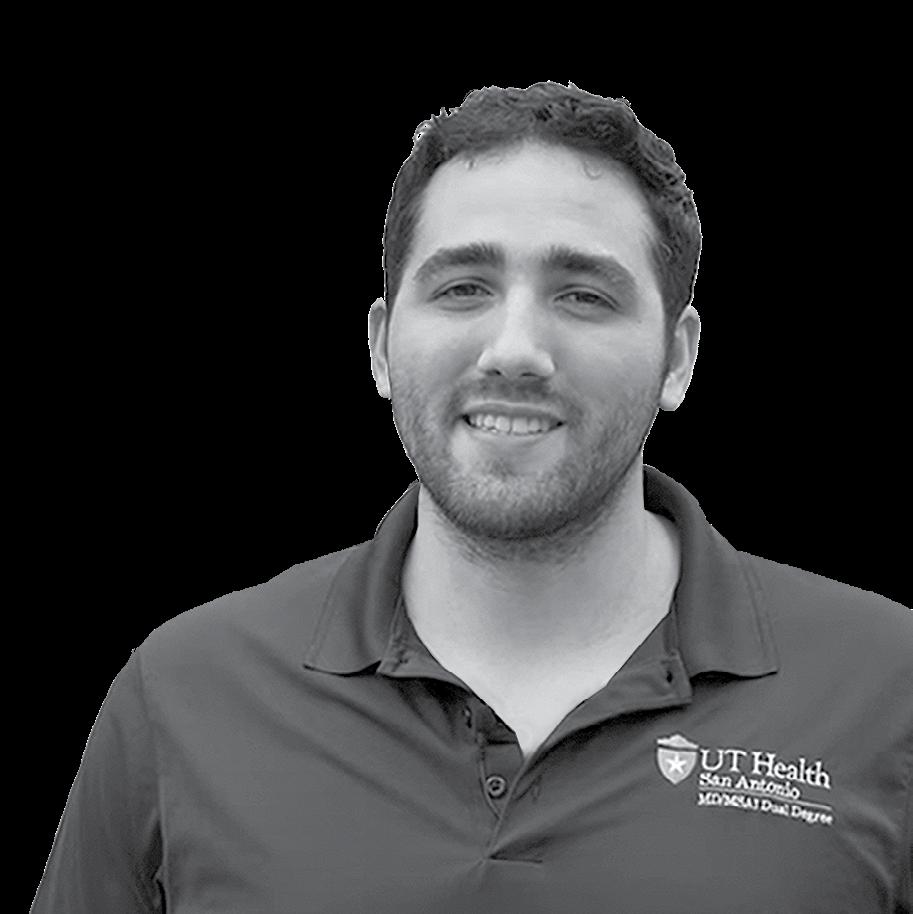

NEXT-GENERATION HEALTHCARE
Aaron Fanous and fellow student Eri Osta made history in the spring of 2024 as the very first graduates of the nation’s first known dual degree in medicine and artificial intelligence (AI), a collaboration between the Joe R. and Teresa Lozano Long School of Medicine and University College, both at UT San Antonio. Launched in 2023, this groundbreaking program prepares the next generation of physician leaders through comprehensive training in applied artificial intelligence. Graduates of the program earn both a Doctor of Medicine and a Master of Science in Artificial Intelligence (M.D./ M.S. in AI).
Fanous enrolled in the program with hopes of pioneering AI applications that would enhance patient care and streamline administrative tasks for medical professionals. The program’s approach allowed Fanous to apply what he was learning in class to solve real-world problems.
Typically, radiologists write reports summarizing the findings of X-rays, CT scans or MRIs and send them to the physician who ordered the imaging. Fanous worked with radiologist Kal Clark, M.D., to develop an AI model that produces radiology reports by detecting and describing what’s found in the images.
“Going through the M.D./M.S. in AI program was an extraordinary experience,” Fanous says. “Learning to build and develop these AI-powered systems for medical use has helped me understand what is important to both fields and will allow me to bridge the gap between technological innovation and medicine to improve lives.” Fanous recently completed a one-year postdoctoral position at Stanford University in California.
WHEN EVERY MINUTE COUNTS
The first 60 minutes following a traumatic injury are so critical that they are commonly referred to as “the golden hour” by healthcare practitioners. A new research collaboration between MATRIX: the AI Consortium for Human Well-Being, the Department of Neurology at UT San Antonio Health Science Center and UT Tyler is utilizing AI tools to identify and lessen potential delays in care during that all-important 60-minute period.
The research project, called the iRemedyACT, is developing AI tools for the field of trauma care that will help clinicians make swift, informed decisions in emergency situations.
When the medical care of severe injuries is delayed, it often results in lower survival rates and longer-lasting effects from trauma for the patients. The research team behind the iRemedyACT expects that AI-informed decision-making will lead to improved survival rates of trauma patients and enhance the overall efficiency of the Texas trauma system.
“There is great potential for AI to positively impact healthcare,” says Amina Qutub, associate professor of biomedical and chemical engineering at UTSA and a lead researcher for the iRemedyACT. From AI software being used for hemorrhage triage in combat settings to a rapid biomarker blood test that can assess traumatic brain injury, she says that AI could potentially unlock profound impacts on trauma care. “The iRemedyACT will accelerate these types of breakthrough translational applications that will save lives and improve quality of life for trauma survivors,” she says.
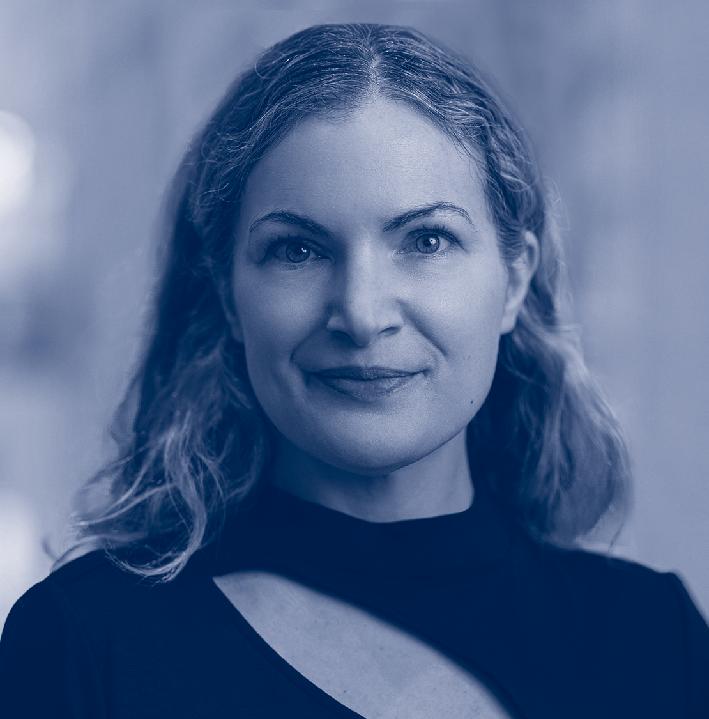
AJDelgado


CHANGING LIVES USING ChatGPT
AJ Delgado, a postdoctoral fellow in the Department of Public Health, has spent his career analyzing data to better understand health disparities. Now, he’s equipping community-based health organizations with the same tools and methods to tackle them head-on. Through specialized training, he’s helping staff from the Ryan White HIV/AIDS Program and the Latino Commission on AIDS make sense of their health data using generative AI.
By translating complex data into actionable insights, these organizations can enhance their grant proposals, create data-driven reports and make stronger suggestions for interventions. In Delgado’s six-week training, he guided community health professionals in ways to analyze data using RStudio, a statistical software, and ChatGPT, a generative AI tool.
“Understanding data is only as complicated as the person explaining it,” Delgado says. “We use numbers all the time. When we purchase items from Amazon, we probably spend more time looking at ratings than the actual product we’re purchasing. We’re using data to make the best decisions. I believe that most health data can be translated in a way that the everyday consumer can use to make better choices about their health.”
Delgado hopes this project will be a catalyst for lasting change — one that will help build a more data-proficient workforce in San Antonio, especially in nonprofits that serve as hubs for access to health care. Ultimately, this work isn’t just about numbers, he says. It’s about people. S


BY SHEA CONNER
Jordyn Jenkins ’25

VISIT SOMBRILLA MAGAZINE ONLINE TO READ THE EXTENDED ARTICLE ABOUT JORDYN’S JOURNEY.
How she bounced back from injury to become one of the greatest athletes in UTSA history
Jordyn Jenkins’ status as one of UTSA’s all-time greats is cemented. She was a two-time conference player of the year, led her team to UTSA’s very first American Conference championship and became the first Roadrunner ever to sign a WNBA contract. But on a spring day in 2023, her profound legacy in orange and blue didn’t seem so inevitable.
During a routine offseason workout, Jenkins planted her leg awkwardly while changing direction and tore the anterior cruciate ligament (ACL) in her right knee. As she laid crumpled on the court and the tears began welling in her eyes, she had doubts that her basketball journey would continue. The timing was especially hard on the elite student-athlete from Renton, Washington, who had not only taken a chance on UTSA after transferring from the University of Southern California, but had also just wrapped up a season in which she was named the 2023 Conference USA Player of the Year.
“I actually remember coming into the training room after it happened. Everyone was just like, ‘oh my gosh, what happened to her?’” Jenkins recalls. She says that several student-athletes she passed by on the way to the training room could sense the gravity of the situation. “I couldn’t stop crying. I couldn’t walk.”
Within minutes, Ken Kenneth-Nwosa, MD, received a text message, a phone call and a video clip of Jenkins’ knee from athletic trainer Tam Nguyen. Kenneth-Nwosa, an assistant professor in the Department of Orthopaedics and the lead team physician for UTSA Athletics, rushed over to the Roadrunner Athletics Center of Excellence to check on Jenkins. They quickly diagnosed the injury and determined that orthopaedic surgeon Thomas DeBerardino, MD, would be the best candidate to reconstruct the ACL through an operation.
In the weeks after the procedure, Jenkins would be first to admit that she was “in the dumps,” crediting Nguyen and Kenneth-Nwosa for their patience and rehabilitation director Marie Charpentier, among others, for helping her maintain her composure.
“After the operation, it’s such a nervous thing,“ Kenneth-Nwosa explains. “You’re filled with anxiety to see if you’re going to recover correctly. Any little tweak — any little discomfort or pain — can masquerade as a setback, so we’re here to give them reassurance.”
But she found the motivation to get back to elite college basketball form, starting off small with leg raises and quad sits. Once she was confident in her mobility, she returned to practice. Assistant coach Cameron Miles helped her get back into “game shape” through shooting, dribbling and ballhandling exercises. Jenkins could have been cautious and sat out the entire 2023–2024 campaign, but when it became apparent that she would be fully healthy for the final month of the season, she set out to put UTSA’s new conference on notice.
Jenkins made her on-court return to great fanfare at the Convocation Center on February 2024. Her return helped the Roadrunners finish strong, earning fourth place in the American Conference and a bid in the Women’s National Invitational Tournament. The notice had been served.
The following season, the 2024–2025 squad stacked win after win, including several hard-fought victories in close contests. Time and time again, the Roadrunners proved that they had the mental toughness to match their talent.
By the time March rolled around, UTSA had amassed a 24–3 overall record and a 15–1 record in conference play. The Roadrunners needed just one more victory to capture the regular-season championship in The American and break the program record for wins in a single season. Thus, the stage was set for the Senior Day showdown at the Convo against Florida Atlantic. Jenkins reveled in the hugs from loved ones and the roaring admiration of the Roadrunner faithful. Another UTSA Women’s Basketball record had been shattered before the game had even tipped off; 2,250 basketball fans packed the Convo to break the program’s singlegame attendance record.
Powered by the electric atmosphere and anchored by a sweltering defensive effort, UTSA cruised to a 60–42 win. Within minutes, the confetti cannons were blasting, the trophy appeared and the conference championship hats and T-shirts had been distributed. Jenkins high-fived every single Roadrunner fan in sight while her teammates and cheerleaders snapped selfies and made confetti angels like carefree kids on a snow day.
Jenkins, who couldn’t stop crying in the training room nearly two years earlier, couldn’t stop smiling.
“We’ve always wanted the confetti and we’ve always wanted to win in front of a big crowd at the Convo, so it was really cool and really rewarding,” she says. “We were the most popular people in the building. Our friends were there. Our families were there. So many pictures. So many autographs. It was just everything that we’ve always wanted.”
At season’s end, Jenkins was named the American Conference Player of the Year. It all felt like the preeminent realization of the vision that UTSA head coach Karen Aston had laid before her as a transfer in 2022 — not just to be a great basketball player, but also a great leader, teammate and groundbreaker. Aston said she will forever appreciate that Jenkins bought into that vision. From attracting WNBA scouts to drawing new fans, she knows the mark that Jenkins left at UTSA is indelible.
“I do believe Jordyn’s jersey will be in the rafters one day,” Aston says. “She will forever be remembered as a changemaker for women’s basketball at UTSA.”
Alumnus who beat cancer is using his biomedical research to pay it forward
Every child has aspirations of what they want to be when they grow up, whether it be a firefighter, police officer or astronaut. For Derek Rodriguez ’23, that dream was to be a medical doctor.
And when at the age of eight he was diagnosed with rhabdomyosarcoma, a rare cancer in children that affects muscle tissue, that experience ignited this passion to want to help other cancer patients.
“When you go through that as a child, you learn to think, ‘Oh, what if I grow up to be a superhero in this field?’ Imagine the impact I could have helping other individuals navigate and enhance their survivorship journey,” Rodriguez says.
Today Rodriguez is 22 years cancer-free and a senior clinical research scientist in the Institute for Health Promotion Research (IHPR) at UT San Antonio Health Science Center.
Before finding his path as a scientist, Rodriguez was set on pursuing medical school and began his undergraduate work in biology at Texas State University. However, it was during his time as a Bobcat that a new passion was ignited — conducting research.
As an undergraduate, Rodriguez researched neuroblastoma, a childhood cancer that develops from immature nerve cells. His passion for research was further solidified when he began his graduate studies at UTSA in 2017.
“I chose graduate school over medical school because I was inspired by the opportunity to drive change at the population level — advancing research and shaping policies that improve health outcomes for entire communities, not just individual patients,” he says.
Rodriguez realized he could marry science and medicine while still honoring his childhood dreams of being in the medical field. In 2023, Rodriguez earned a doctorate in translational science, which is a joint doctoral degree between UT San Antonio, UT Austin and UT Health Houston School of Public Health. The program creates scientists who can advance basic biomedical knowledge and engage with clinical and community insights to translate discoveries into effective strategies that improve healthcare delivery, patient outcomes and community health.
And that’s exactly what Rodriguez is doing as a scientist in the IHPR. Rodriguez is a project manager for the Avanzando Caminos: The Hispanic/Latino Cancer Survivorship Cohort Study and helps lead the Avanzando Salud: Cancer Health Research Center, both under the director of IHRP, Amelie Ramirez, DrPH, MPH.
“The study looks to unpack some of the cultural, biological, medical, social and psychosocial factors that shape the post-cancer experience among Latino cancer survivors,” he says. “It will be the largest cohort study enrolling 3,000 Latino cancer survivors across South Texas and South Florida.”
The Center’s work is grounded in addressing non-medical drivers of health and advancing cancer prevention, outcomes and survivorship through research, mentoring and community engagement.
Rodriguez, who is looking to become an assistant professor of research, is very proud of the work he’s done.
“My younger self would be proud. Back then, I thought the only way to make a difference was through medical school. I never could have imagined the path I’d take — one filled with unexpected turns and new opportunities. But in the end, I found a way to serve others and create change in a way that’s just as meaningful. It’s a reminder that purpose doesn’t always follow a straight line,” says Rodriguez.
“In the end, I did exactly what I set out to do — help a community close to my heart. Now I have the opportunity to serve an underrepresented population and work toward a mission of preventing cancer before it starts. I remember thinking as a child, ‘If cancer is affecting me this deeply, what about others like me who are living with the same fears, the same exhausting cycles of treatments?’ That question has stayed with me and continues to drive everything I do.”
As Rodriguez looks toward his future career path, he hopes to one day establish his own research institute or work in a clinical setting focused on advancing research and education. S
I was inspired by the opportunity to drive change at the population level — advancing research and shaping policies that improve health outcomes for entire communities, not just individual patients.
BY VALERIE BUSTAMANTE JOHNSON
VISIT SOMBRILLA MAGAZINE ONLINE TO READ THE EXTENDED ARTICLE ABOUT DEREK’S JOURNEY.

Derek Rodriguez ’23







OUR LARGEST FUNDRAISING CAMPAIGN IN UNIVERSITY HISTORY GARNERED THE INCREDIBLE SUPPORT OF MORE THAN 60,000 DONORS AND THE ENGAGEMENT OF OVER 110,000 ALUMNI!
BECAUSE OF YOU, UTSA ACHIEVED HISTORIC MILESTONES AND IS POSITIONED FOR GREATNESS AS WE TRANSITION TO OUR NEXT BOLD CHAPTER TOGETHER. RAISED FOR GROUNDBREAKING RESEARCH
ENDOWED SCHOLARSHIPS AND FELLOWSHIPS CREATED TOTAL RAISED Visit our campaign website to learn about the transformative impact of Be Bold: A Campaign for Our Future. 139 139 $225M+ $225M+ $500M+ $500M+

